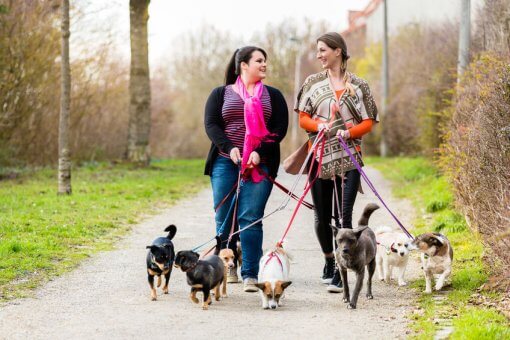If you like pets, a dog walking business could be a great idea. But what should you know before officially becoming a dog walker? Are there any licenses or insurances to have, regulations to follow?
Being a dog walker means walking dogs for their owners in exchange of money. If you’re a dog lover, it can be a perfect opportunity to both do something you like and to make money off of a hobby. It is also a convenient activity if you want a part-time or a supplemental job, since walks usually last from 30 minutes to an hour, and you can walk several dogs at the same time if you have the skill (and can keep your wits about you!). And if you think you would benefit from getting some fresh air more often, it’s a pleasant way to start.
How Much Should You Charge For Dog Walking?
The first thing you’ll need to do is fix your prices. In order to do that, you should do a little benchmarking in order to know how much dog walking business owners of your area are charging for a walk.
In the UK for example, dog walkers charge an average £6 to £10 per dog for walks lasting 30 minutes to an hour. In the US, prices are a bit more complex due to more various options. According to Angie’s list blog, it’s about $15 to $20 for a 15 to 20 minutes’ walk and $20 to $30 for 30 minutes to an hour. Plus, if someone wants you to walk more than one dog, it usually adds $5 to $10 to the walk.
However these are indicative and average prices. Depending upon how prosperous your neighborhood is, and also upon the demand for dog walking, you may need to adjust your pricing, so don’t forget to do a little research. And don’t forget to plan on having a discount for regular customers.
How to Make a Business Plan for a Dog Walking Business?
Having your prices fixed is great, but it’s only the first step in creating your dog walking business. If you want to take the fewest possible risks and make the best out of your business, you need to think about certain things in order to make your business plan ready. You can download a free Excel business and financial plan template here and you’ll below you’ll find the key questions to ask yourself when you want to set up a dog walking business.
What is the right legal structure for your business?
As you can imagine, you’ll need to register your company with the institution in charge in your country or State. But before that, you need to decide which legal structure is appropriate.
Lucky for you, we wrote a bunch of articles related to business structures in France, UK and the United-States. While checking this out, don’t forget that walking dogs is not risk-free. If a dog is injured during one of your walks, it’s better if you’re not personally responsible. However, setting up a limited liability companies involve more paperwork and more money than being a sole trader (or sole proprietor). It’s not something to take lightly.
What are the costs related to your dog walking business?
Even if they are minor for a dog walking business because you won’t need to rent an office or buy high tech or industrial material, they still are costs you’ll have to take into account in order to maintain your business. Here is a quick list.
- Registering fees: depending on the legal structure you choose for your business, you may have to pay fees for registering. Also, in the US, you may need a business license, so don’t forget to see if it applies to you.
- Bank account: for accounting reasons, it’s best to separate your business from your personal accounts.
- Marketing: do you need flyers? A website? Business cards?
- Insurance: if you like dogs enough to think of starting your own dog walking business, you probably also think their safety is important. This is why you need a good insurance policy. Of course, there are specific insurance for businesses involving pets. And if you use a car while working, you need proper vehicle insurance.
- Supplies: Although you won’t feed the puppies you’ll be walking, you’ll need supplies. The minimum to have is waste bags, an extra leash and collar and some treats maybe.
- Pet first aid class and CPR certification: if you don’t have a lot of dog walking experience, attending a pet first aid class can only benefit you. Not only will you learn a lot and be fully prepared to start our new job, but it will also help you reinforce your credibility and convince customers to choose you instead of someone else!
